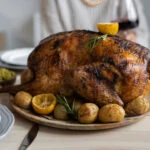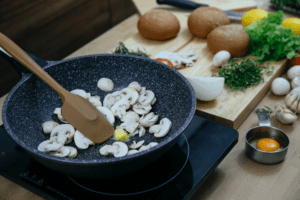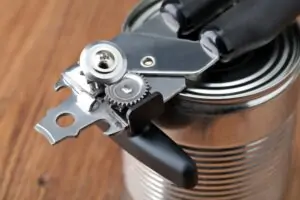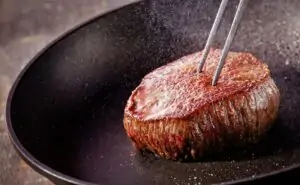When you put a saucepan and a pot side by side, it can be hard to tell what makes them unique. While these two pieces of cookware have specific uses, we have to admit: they look pretty close in appearance.
When building up your roster of cookware, it can be hard to decide what pieces you need and which you don’t. Not all of us are blessed with unlimited cookware storage space, so it’s important to invest in pieces you’ll get the most use out of. When it comes to picking between a saucepan and a pot, we want you to pick the one that will be most useful to you.
Saucepans and pots may seem similar, but when you get down to the details, there are actually a lot of things that make these two pieces of cookware distinct. Let’s break down the ways saucepans and pots are similar and the ways they’re different.
What is a Saucepan?
A saucepan is a piece of cookware that features a narrow, circular base, tall, straight sides, and a single attached handle. They are small in size (between 1 quart and 4 quarts) and will often include a lid to help them retain heat.
A sauce pan is meant for making sauces but is adept at pretty much any cooking with liquid. Their design makes it easy to quickly and evenly heat sauces, as the heat will travel from the base up the sides. Their small size also helps them to heat up and cool down quickly.
This design is perfect for sauce making. Sauces are usually made in smaller quantities and require excellent temperature control throughout cooking, which is what the sauce pan is made for.
What is a Pot?
In the cookware world, the word pot is an umbrella term that covers a wide variety of tools. At its most basic definition, a pot is a piece of cookware with a circular base, tall, high walls, and two handles on either side of the bowl. They have a wide range of sizes (8 quarts and up on average) and also often include lids.
There are many different kinds of pots that cooks use in kitchens today. Huge, deep stock pots are perfect for making large quantities of soups or stews. A pasta pot will be smaller in size, so you can easily strain noodles. There are even steamer pots, designed to steam vegetables, and double boilers, used for things like candy making.
Like a saucepan, a pot is primarily used for cooking liquids. However, due to the wide range of sizes and shapes, like a soup pot, casserole pot, pasta pot, stock pot, and sauce pot, you can also use them for different, non-liquid foods.
What Makes a Saucepan and a Pot Different?
What are the differences between these tools? Well, it boils down to some specific differences across a few categories. Let’s compare the saucepan and pot further to see what makes them unique:
Cooking Quantities
While the saucepan and cooking pot are both great at cooking liquids, there are differences in the cooking methods they’re best at. They have two very distinct size ranges. The average saucepan will be anywhere from 1 quart to 4 quarts in size. In comparison, the average pot size is 8 quarts and can come as large as 100+ quarts in commercial kitchens.
As saucepans are rather small in size, they’re not the best vehicle to make large quantities of something. They can make enough sauce for a topping, like a tomato sauce for spaghetti or gravy for potatoes. They’re also great if you need to hard boil enough eggs for two. They’re also good at making large quantities of smaller grains like rice or couscous.
If you want to make enough soup to feed the family, a pot is the better choice. Pots come in larger sizes and can fit a much bigger volume. If you are making stock, cooking a family-sized chili, or cooking professionally, you need something bigger than a saucepan. Your saucepan is better suited to reheating a portion of soup than making one big enough for a crowd.
Heat Retention
The size differences between these two also affect the heat they hold while cooking. As we touched on earlier, saucepans are known for their ability to quickly and evenly distribute heat. Because they are so small, they can take on heart pretty quickly. Their small size also helps them cool down when removed from heat, so you can heat and cool down with ease while cooking.
A pot is also good at evenly distributing heat, featuring the same high sides and lid of a saucepan. However, they don’t do it with nearly as much speed, which is to a pot’s benefit as they should cook low and slow.
When cooking stocks, soups, or stews, use a cooking utensil that can slowly take on the heat and keep your liquid at a constant, simmering temperature. This makes the pot the perfect vessel for slow cooking.
When you need a specific kind of temperature control, the differences between these two can matter! It all depends on what and how you’re cooking.
Mobility
The handles on saucepans and pots give distinct types of movability in the kitchen.
With a saucepan, it’s all about speed. These pans feature a single, long, heat-resistant handle on one side of the pot. The single handle gives the saucepan the moving style needed when cooking things like sauces.
With a single handle and a small pan size, you can take your sauce off the heat and then put it back on with ease. The single handle is also great to give you distance and control when pouring liquid content out of the pan into another vessel.
Working with sauces can be quick work! You need a lightweight saucepan that moves fairly easily and travels with you from the stovetop to other parts of the kitchen.
In comparison, the handles on the average pot are designed to help you move its heavier contents. Most pots hold a lot more mass than the average saucepan. Hot liquids can be dangerous to transport in a kitchen, so you need to move the cookware it’s prepared in with care.
The double handles found on either side of the pot will help you keep its heavyweight stable. It will also help you safely pour out its contents, giving you more control than a single handle would.
While you can’t move pots with the same ease and speed as you could a saucepan, its double handles benefit it in this different way. Again, the differences here come down to the types of cooking these tools are intended to do.
Can You Use a Pot as a Saucepan?
What happens if you can’t have both a pot and a saucepan? Which should you choose?
Technically, you can use a pot as a saucepan or even a saucepan as a pot. The only problem is they differ in cooking techniques. You won’t get the best cooking experience possible when you exchange these two tools.
You can use a saucepan to create and heat sauces if you are without a saucepan. The drawback, though, is that it takes the pot much longer to heat up, which affects any sauces that require you to make changes in temperature, such as a bearnaise.
The same issue happens when we exchange a saucepan for a pot. Since saucepans can get hotter, faster, you have a higher chance of burning or scorching food rather than slow cooking like a pot can. Saucepans are also significantly smaller in size. If you’re trying to feed a family, the size of a saucepan might not cut it when it comes to proper portions.
Both a saucepan and a pot can hold and heat liquids, so it is possible to get away with using either one! The choice is up to you.











